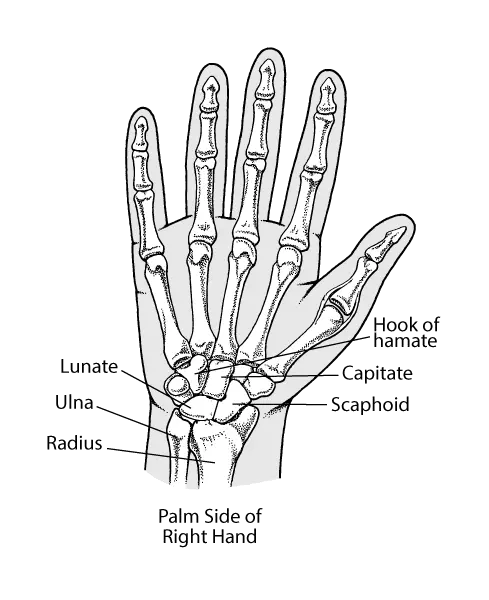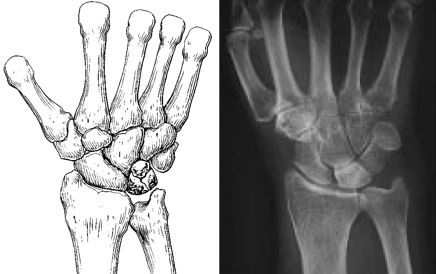What Is Kienböck’s Disease?
Kienböck’s disease is a rare condition that affects the wrist. It is also known as avascular necrosis of the lunate bone. The lunate bone is one of the small bones located in the wrist joint, and it is susceptible to damage due to poor blood supply. Kienböck’s disease occurs when the blood supply to the lunate bone is disrupted, causing the bone to die and collapse. This can lead to pain, stiffness, and limited mobility in the wrist.

What Are the Symptoms of Kienböck’s Disease?
The symptoms of Kienböck’s disease can vary depending on the stage of the disease, but some common symptoms include:
Pain in the Wrist: Pain is usually the first symptom of Kienböck’s disease. The pain may be localized to the wrist or may radiate to the forearm or hand. The pain may be worse with activity or gripping.
Swelling: Swelling may occur around the wrist joint and may be accompanied by stiffness.
Reduced Range of Motion: Kienböck’s disease can cause a decrease in the range of motion of the wrist, making it difficult to perform certain activities.
Tenderness: The wrist may be tender to the touch, especially over the lunate bone.
Weakness: The wrist and hand may feel weak, making it difficult to grip or hold objects.
If you are experiencing any of these symptoms, it is important to consult an expert doctor or a hand specialist for an evaluation. Early diagnosis and treatment can help prevent the progression of the disease and reduce the risk of complications.
How Is Kienböck’s Disease Diagnosed?
To diagnose this condition, your doctor will typically perform a physical exam, take a medical history, and order imaging tests.
During the physical exam, the doctor will examine the wrist for any signs of swelling or tenderness. They may also move the wrist through a range of motions to assess its mobility and check for any clicking or popping sensations.
The medical history will involve asking the patient about their symptoms, how long they have been experiencing them, and if there are any factors that may have contributed to the development of the condition, such as a previous injury or repetitive use of the wrist.
Imaging tests, such as X-rays, CT scans, and MRI scans, can provide detailed images of the wrist bones and joints. These tests can help the doctor identify any changes or abnormalities in the bones and cartilage that may indicate Kienböck’s disease. In some cases, additional tests such as a bone scan or arthroscopy may be recommended to confirm the diagnosis.
It’s important to note that Kienböck’s disease can be difficult to diagnose, as its symptoms may be similar to those of other conditions, such as arthritis or carpal tunnel syndrome.
What Are the Stages of Kienböck’s Disease?
There are four stages of Kienböck’s disease, which are used to describe the severity of the condition. The stages are determined based on X-rays, MRI scans, and physical examination.
Stage I: In the early stages, the lunate bone may appear normal on X-rays, but an MRI may show evidence of decreased blood supply. Patients may experience mild pain and swelling in the wrist.
Stage II: In this stage, the lunate bone may begin to show signs of collapse or damage on X-rays. Patients may experience increased pain and difficulty using the wrist.
Stage III: The lunate bone may be significantly collapsed or damaged in stage III, and other bones in the wrist may begin to shift. Patients may experience significant pain, stiffness, and loss of wrist function.
Stage IV: This is the most severe stage of Kienböck’s disease, in which the lunate bone has collapsed completely and the wrist joint is severely damaged. Patients may experience chronic pain, limited mobility, and may require surgery to manage their symptoms.
What Are the Surgical Treatments for Kienböck’s Disease?
Most common surgical treatments for Kienböck’s Disease are;
Joint Leveling
Joint leveling is a surgical procedure used to relieve pain and restore function in patients with Kienböck’s disease, a condition in which the blood supply to a bone in the wrist is disrupted. This procedure involves removing a small piece of bone from the radius to lower the height of the joint and decrease the pressure on the lunate bone.
Revascularization
Revascularization is a surgical procedure that aims to restore blood flow to the bone affected by Kienböck’s disease. During the procedure, the surgeon may use a small blood vessel from another part of the body to bypass the blocked or damaged blood vessels in the wrist.
Fusion
Fusion is a surgical procedure that aims to permanently join two bones together, typically using a combination of bone grafts and metal hardware. This is often used as a treatment for advanced stages of Kienböck’s disease, where the affected bone has collapsed or degenerated.
Implant Arthroplasty
Implant arthroplasty is a surgical procedure in which an artificial joint is inserted to replace the damaged bone in the wrist affected by Kienböck’s disease. This procedure may be recommended for patients who have not responded to other treatments or who have advanced stages of the disease.
Proximal Row Carpectomy (PRC)
Proximal row carpectomy (PRC) is a surgical procedure that involves the removal of one or more bones in the wrist, typically the proximal row of carpal bones. This procedure may be used as a treatment for early to moderate stages of Kienböck’s disease, and aims to preserve motion and function in the wrist while removing the damaged bone.
How Long Does It Take for a Scaphoid Bone Injury to Heal?
The scaphoid bone is one of the small bones in the wrist that can be easily injured, especially during falls or high-impact activities. The healing time for a scaphoid bone injury can vary depending on several factors such as the severity of the injury, the location of the fracture, and the age and overall health of the patient.
In general, it takes around 8-12 weeks for a scaphoid bone injury to heal if it is a non-displaced fracture, meaning the bone is still in its proper position. However, if the fracture is displaced, meaning the bone is out of its proper position, or if there are other complications such as blood supply disruption, the healing time can be significantly longer.
What Is the Recovery Process for Kienböck’s Disease?
The recovery process for Kienböck’s disease depends on the severity of the condition and the type of treatment received. After surgery, patients typically wear a splint or cast for several weeks to immobilize the wrist and support healing. Physical therapy may also be recommended to improve range of motion and strength in the wrist.
Following surgery, patients may experience some pain and swelling, which can be managed with pain medication and ice packs.
In some cases, full recovery may take several months or longer, especially for more extensive surgical procedures such as joint leveling or revascularization. Regular follow-up appointments with a healthcare provider can help monitor progress and make any necessary adjustments to the treatment plan.
Kienböck’s Disease FAQ
What Can I Do to Prevent or Reduce My Risk of Kienböck’s Disease?
While it is not always possible to prevent Kienböck’s disease, there are some steps you can take to reduce your risk of developing the condition. These include avoiding repetitive stress on the wrist, maintaining a healthy lifestyle, and seeking early treatment for any wrist injuries.
What’s the Outlook for People with Kienböck’s Disease?
The outlook for people with Kienböck’s disease varies depending on the stage of the condition and the severity of symptoms. In some cases, nonsurgical treatments may be effective in relieving pain and restoring function. In more advanced cases, surgical intervention may be necessary to prevent further damage to the wrist.
What Are the Nonsurgical Treatments for Scaphoid?
Nonsurgical treatments for scaphoid injuries may include immobilization of the wrist with a cast or splint, the use of nonsteroidal anti-inflammatory drugs (NSAIDs) to relieve pain and inflammation, and physical therapy to improve strength and flexibility in the wrist. It is important to seek prompt medical attention if you suspect a scaphoid injury to ensure the best possible outcome.
Can Kienböck’s Disease Go Away on Its Own?
Unfortunately, Kienböck’s disease is a chronic condition that doesn’t go away on its own. However, with proper treatment and care, symptoms can be managed effectively.
Can Kienböck’s Disease Get Worse?
Yes, Kienböck’s disease can get worse over time if left untreated or if the underlying cause of the disease isn’t addressed. It’s important to seek medical attention as soon as symptoms appear.
What Are the Symptoms of a Scaphoid Bone Injury?
Symptoms of a scaphoid bone injury include pain and swelling in the wrist, tenderness in the area of the scaphoid bone, difficulty gripping or holding objects, and limited range of motion in the wrist.
What Questions Should I Ask My Healthcare Provider About a Scaphoid Bone Injury and Its Treatment?
Some important questions to ask your healthcare provider include:
- What is causing my symptoms?
- What are my treatment options, and what are the benefits and risks of each?
- How long will my recovery take?
- Are there any restrictions on my activities during my recovery?
- How can I prevent further injuries or recurrence in the future?








